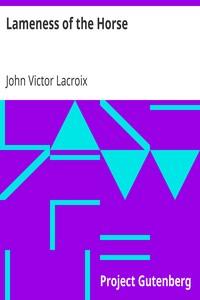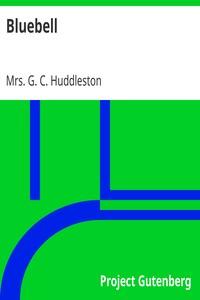|
|
Read this ebook for free! No credit card needed, absolutely nothing to pay.Words: 24788 in 19 pages
This is an ebook sharing website. You can read the uploaded ebooks for free here. No credit cards needed, nothing to pay. If you want to own a digital copy of the ebook, or want to read offline with your favorite ebook-reader, then you can choose to buy and download the ebook.

: Lameness of the Horse Veterinary Practitioners' Series No. 1 by Lacroix John Victor - Horses Health; Lameness in horses Zoology@FreeBooksTue 06 Jun, 2023 nates with the trochlea of the femur, comparatively little energy is required to prevent further flexion of the stifle joint. The patella, according to Strangeways, may be considered a sesamoid bone. The quadriceps group of muscles is assisted by the anterior digital extensor peroneus tertius and tibialis anticus muscles. The latter pair are enabled to automatically flex the tarsal joint when the stifle is flexed. The hock is kept fixed in position by the gastrocnemius and the superficial digital flexor . The latter structure, which is chiefly tendinous, originates in the supracondyloid fossa of the femur and has an insertion to the summit of the fibular tarsal bone. It relieves the gastrocnemius of muscular strain during weight bearing. Smith styles the function of the stifle and hock joints a reciprocating action, and we quote from this authority the following: From what has been said, it is evident that flexion and extension of stifle and hock are identical in their action. When the stifle is extended, the hock is automatically extended, nor can it under any circumstances flex without the previous flexion of the stifle. There is no parallel to this in the body. The two joints, though far apart, act as one, and they are locked by the drawing up of the patella, and in no other way. The so-called dislocation of the stifle in the horse is a misnomer. That the patella is capable of being dislocated is beyond doubt, but the ordinary condition described under that term, when the stifle and hock are rigid while the foot is turned back with its wall on the ground, is nothing more than spasm of the muscles which keeps the patella drawn up. The moment they relax the previously immovable limb and useless foot have their function restored as if by magic, but are immediately thrown out of gear in the course of a few minutes as a recurrence of the tetanus of the petallar muscle takes place. The fascia of the thigh, like that of the arm, is a most potent factor in giving assistance to the constant strain imposed on the muscles of the limbs during standing. Below the hock the hind limb is arranged like that of the fore, the deep flexor receiving its additional support from the "check ligament," as in the fore leg. The natural attitude of standing adopted by the horse is to rest on three legs--one hind and two fore. If he is alert, he stands on all four limbs; but if standing in the ordinary manner, he always rests on one hind leg. He does not remain long in this position without changing to the other. Hour by hour he stands, shifting his weight at intervals from one to the other hind leg, and resting its fellow by flexing the hock and standing on the toe. He never spares his fore-limbs in this manner in a state of health, but always stands squarely on them. Hip Lameness. Fortunately, because of the heavy musculature which goes to form a part of the locomotive apparatus of the rear extremity, hip lameness is comparatively rare. While the term is in itself ambiguous and signifies nothing more definite than does "shoulder lameness," yet diagnosis of almost any condition that may be classed under the head of "hip lameness" is not easy except in cases where the cause is obvious, as in wounds of the musculature and certain fractures. To the complexity which the gait of the quadruped contributes, because of its being four-legged, there is added the complicated manner of articulation of the bones of the hind leg. This involves the hip in the manner of diagnostic problems and because of the inaccessibility of certain parts, owing to the bulk of the musculature of these parts, diagnosis of some hip ailments becomes an intricate problem. Consequently, in some instances, before one may arrive at definite and enlightening conclusions, repeated examinations are necessary as well as a knowledge of reliable history and recorded observations of the subject over a considerable period. Rheumatic affections, when present, usually cause recurrent attacks of lameness; myalgia, due to subsurface injury occasioned by contusion, generally produces an ephemeral disturbance; and while these are examples of cases where occult causes are active, they are by no means unprecedented. In cases where the cause of lameness is not definitely located, and when by the process of exclusion one is enabled to decide that the seat of trouble is in the hip, a tentative diagnosis of hip lameness is always appropriate. In one instance a Shetland pony evinced a peculiar form of intermittent lameness which affected the left hip, and repeated examinations did not disclose the cause of the trouble. After about a year there was established spontaneously an opening through the integument overlying the region of the attachment of the psoas major , through which pus discharged. With the occurrence of this fistula, lameness almost entirely disappeared, but the emission of a small amount of pus persisted for more than a year. The subject was not observed thereafter and the outcome in this case is not a matter of record. Whether there existed a psoic phlegmon due to metastatic infection or necrosis of a part of a lumber or dorsal vertebra is a matter for speculation. Thus the presence of some anomalous conditions which affect the pelvic region and cause lameness may be discovered, yet both in hip and shoulder regions causes may not be definitely located by means of practical methods of examination. Injuries of all kinds are the more frequent causes of hip lameness. In such cases, lameness may result directly and resolution be prompt, or the claudication become aggravated in time, due to muscular atrophy or degenerative changes affecting the hip joint or nerves. Rheumatism or metastatic infection may be the cause of hip lameness as well as affections of the pelvic bones, lumbar and sacral vertebrae. Hip lameness may also be provoked by melanotic or other tumors. Free books android app tbrJar TBR JAR Read Free books online gutenberg More posts by @FreeBooks
: Scientific American Supplement No. 620 November 191887 by Various - Science Periodicals Scientific American@FreeBooksTue 06 Jun, 2023

: Scientific American Supplement No. 421 January 26 1884 by Various - Science Periodicals Scientific American@FreeBooksTue 06 Jun, 2023
|
Terms of Use Stock Market News! © gutenberg.org.in2025 All Rights reserved.






